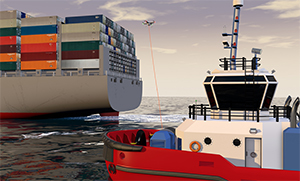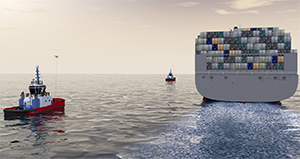A Netherlands-based towing company is developing an aerial drone that can deliver a messenger line from a tugboat to the ship being escorted, allowing the tug and its crew to stay out of the danger zone around the hull.
Kotug, headquartered in Rotterdam, is performing land tests of the device and hopes to begin testing on vessels in mid-2018.
“It is mainly driven by safety,” said Koos Smoor, Kotug’s manager of fleet performance and innovation. “It is mainly for the guy on deck.”
Traditionally, a tugboat comes close to the bow or stern of an assisted vessel in order for the tug’s crew to grab the heaving line from the ship. This can put the crew in danger since the tugboat is often under the bow of the ship or in its propeller wash.
Even a small mistake can result in injuries to the deck crew or damage to the tug and the assisted vessel, according to Kotug. By using a drone, a tug can operate beside the ship rather than right next to it at the bow and stern.
“Instead of picking up the heaving line of the assisted ship, the messenger line of the tug will be brought to the assisted ship in a more controlled manner,” the company said.
To begin the operation, the tug captain points a camera on the drone to its destination on the assisted vessel, Smoor said. The drone calculates its trajectory, flies from the tug and carries the messenger line to the bow or stern of the ship. The drone emits a sound and flashes a light to let the crew know the line is ready to be picked up. Then the drone returns to the tug. This technique also can be used by tugs assisting the movement of drilling rigs and platforms.
The biggest challenge for Kotug has been developing object recognition software so the drone can identify different vessel shapes to allow it to fly where the line needs to go, Smoor said. The company has been working on the project for the past year and a half.
The drone has four motors and measures about 24 inches in diameter. It carries a line that weighs about 2 pounds per 650 feet. Smoor declined to name the company that is providing the base model.
Previous development of drones in the maritime industry has focused on delivering items — medicine or spare parts, for example — to offshore vessels, remotely inspecting a vessel’s cargo holds and ballast water spaces, monitoring the routes of vessels going in and out of port, and evaluating offshore wind turbines.
 |
|
By employing drones, escort tugs can sail more safely alongside ships instead of getting close to the bow and stern to connect towlines. The line delivery system also can be used to assist drilling rigs and platforms when they are moved. |
|
Courtesy Kotug |
In 2015, the class society DNV GL tested drones to help perform hull surveys of two vessels at the Remontowa Shipyard in Gdansk, Poland. In 2016, Maersk Tankers tested a drone that carried a package of butter cookies about 850 feet to the deck of a vessel off Denmark. That same year, a drone was used to inspect a drillship in the Gulf of Mexico.
Kotug is the first company that is testing a drone to deliver towlines, Smoor said.
David Twining, chief operating officer for Planck Aerosystems of San Diego, Calif., said he is confident Kotug will be successful in its application of drones. “I applaud them for tackling a really ambitious project,” he said. “I think it’s great. It shows how much opportunity there really is in the maritime space for unmanned aircraft.”
Planck Aerosystems has developed a drone called the Shearwater that was released in early 2017. It can be used for emergency oil spill response; surveys of shorelines and objects in the water, such as boats or sandbars; and maritime science and research. Twining said the Scripps Institution of Oceanography purchased a Planck drone that is used for the observation of marine animals, and the company is talking to U.S. companies about using drones for port security.
The Shearwater weighs about 8.5 pounds and can make an autonomous landing on a moving vessel. It can operate in 25-knot winds, Twining said. Theoretically, its range could be about 15 miles, but in order to deliver high-resolution video to a vessel, its range is about 1.25 miles. A skilled pilot is not needed to operate the Shearwater. It is designed to carry a payload of 2.2 pounds, but Planck has modified it for a customer to carry an item weighing more than 17 pounds, Twining said.
Another challenge in the development of drones for maritime use will be federal and state regulations. Right now, Kotug is only allowed to test its drone at an approved site, Smoor said.
In the United States, drone use is governed by separate federal entities. When a drone is on a vessel, it is regulated by the U.S. Coast Guard, according to Sean Pribyl, an attorney who specializes in maritime issues for Blank Rome in Washington, D.C. But when the drone takes off, it has to follow Federal Aviation Administration rules.
“Now you have this unique intersection of the aviation and maritime industries,” Pribyl said. “There are a number of layers that an operator has to understand.”
That factor may be a sticking point in the United States for maritime drone applications. “It can be difficult for a maritime operator who has not had experience with aviation,” Pribyl said. “That involves a new layer of complexity that may discourage an operator from taking the next step to see if it adds value.”

